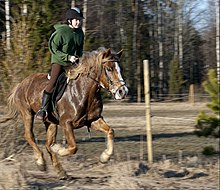Finnhorse
In English it is sometimes called the Finnish Universal, as the Finns consider the breed capable of fulfilling all of Finland's horse needs, including agricultural and forestry work, harness racing, and riding.
The average height of the breed is 15.1 hands (61 inches, 155 cm), and the most typical colour is chestnut, often with white markings and a flaxen mane and tail.
Due to mechanisation of agriculture and the dismantling of Finnish horse cavalry in the late 20th century, the Finnhorse population plummeted from a high of just over 400,000 animals in the 1950s to a low of 14,100 in 1987.
The neck should be well-shaped and not underslung or ewe-necked;[2] the body should be on the long side, but rounded and proportionate; and the croup should neither be level nor with a too-high connection to the tail.
[37] In addition to achieving the minimum scores for both workability and conformation, stallions accepted for the working-horse section of the stud book are required to trot 1,000 metres (1,100 yd) in less than 2 minutes and 30 seconds.
It lacks some traits required for competing at the highest levels of international riding sports,[61] but its combination of size and good temperament makes it suitable for both adults and children.
[70] The stud book evaluation board considers the performance of horses in their desired discipline: riding, driving, harness racing, or workhorse events.
[42] Individuals that do not qualify for the studbook on their own merits during the stud book evaluation process may be accepted later, based on the quality and accomplishments of their offspring.
In addition to functionality as military and working horses, the Finnhorse has also been bred for speed in harness racing, and it can be argued that this sport was the main factor in the survival of the breed after its numbers crashed during the later half of the 20th century, from approximately 400,000 animals in the 1950s to 14,000 in the 1980s.
[78] The other main theory suggests that non-Viking peoples, who migrated into Finland from the southeast and south, brought with them horses of Mongolian origin that had been further developed in the Urals and Volga River regions.
[78][79] The eastern origin of the breed was first proposed by archaeologist Johannes Reinhold Aspelin, who published Suomalaisen hevosen kotoperäisyydestä ("On the Nativity of the Finnish horse") in 1886–1887.
[80] Aspelin proposed that Finnish horses descended from an animal that had accompanied the migration of Finnic peoples from the Volga region and middle Russia to the shores of the Gulf of Finland.
A similar idea was suggested over a hundred years earlier by natural historian Pehr Adrian Gadd, and this theory has continued to receive support into modern times.
[80] The Swedish professor Eric Åkerblom even suggested that the Finnish horse spread along river valleys to Troms, Norway, and was the ancestor of the Nordlandshest/Lyngshest, found around the Lyngenfjord.
[80] In addition, Rislakki suggested that the Finns came across European horses of Spanish and French origin during the first few centuries CE, larger in size and with narrow foreheads.
Almost 20 years later, during the Continuation War, Rislakki also measured Karelian horses, and proposed they also came from an original Northern European animal descended from the Tarpan.
A later ethnologist, Kustaa Vilkuna (1902–1980)[87] supported this view, proposing that an "Estonian-Finno-Karelian pony" descended from a small forest horse previously widespread in the lands surrounding the Gulf of Finland.
[85] In 1550, he gave orders that "stud manors" (Finnish: siittolakartano) be founded on royal farms (Sw: kungsgård), not only in Sweden but also in every municipality of Finland.
[64] For about 30 years, these stallions influenced the local horse population outside the military school as well, and a number of writings from the 19th century mention a "Haapaniemi breed".
[93] Similar if smaller crossbreeding programs developed elsewhere; at Tavinsalmen kartano, the royal estate (kungsgård) of Tavinsalmi, at least one of the mares had been imported from Sweden.
[64][79] The "Hali breed", descending from the stallions of Sarkkila, was an important influence in the pedigree of a few notable Finnhorse trotter sires such as Eino 680 and his son Eino-Vakaa 25.
Swedish count Carl Gustav Wrangler, a respected hippologist of the time, mentioned in his report that Finns were then importing Norfolk Trotters for crossbreeding purposes.
[17][64][89] At the beginning of the century, during the Great Northern War campaigns of Charles XII, the Finnish cavalry was larger than at any other time in history, and almost every usable horse of Finland was needed.
[96][97] The scope of the programme was later expanded to include eight provinces, and Finland was divided into breeding districts, which were all to have a state-owned stallion available to service local mares.
Official guidelines for the selection of stallions were never given, but one common aim throughout Finland was to increase the size and bulk of the horse population to create a type better suited for agricultural work.
[78] In the beginning of the 19th century, German historian Friedrich Rühs especially blamed the west coast estates for damaging the Finnish horse by crossbreeding.
[105] Harness racing and associated parimutuel betting, and to some degree also the relatively new hobby of riding, became the most important factors ensuring the survival of the breed.
[111][113] In the mid-19th century, manor owners in Estonia found the native Estonian Horse too small for their agricultural needs, and concluded that the population would benefit from crossbreeding.
[79] The state stud farm of Tori was founded as the central base for the new Estonian breed in 1856, and ten Finnish mares and three stallions were bought for its needs.
One Finnish-Arabian stallion, Orro, has had noteworthy influence on the modern-day Tori horse, through his widely used great-grandson Harun 42 T.[79] Approximately 75 percent of Finnhorses are used at some point in their lives for harness racing, with riding being the second most popular use.




















